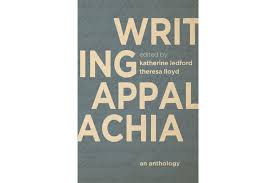This is it. More than a decade in the making, this 745-page tome gives us an overview of Appalachian Literature that far surpasses its predecessors, Voices from the Hills: Selected Reading of Southern Appalachia by Robert Higgs and Ambrose Manning (1975) and Appalachian Inside Out: A Sequel to Voices from the Hills by Jim Wayne Miller, Robert Higgs and Ambrose Manning (1995).
This anthology is expansive in practically every aspect. In genre, it includes fiction, creative non-fiction, poetry, drama, slave narrative, folklore, song lyrics, an address, a diary excerpt, testimony at a congressional hearing. and articles from periodicals. In time, it starts with "How the World Was Made," a traditional Cherokee story and ends with "Candy" a memoir that Denise Giardina has not yet finished, let alone published. Included are 35 21st Century writers; 27 from roughly the second half of the 20th Century; 28 from roughly the first half of the 20th Century, 6 from the 1800s and 7 from earlier. It includes 4 Cherokee authors, 11 African-American writers, 8 that I am aware have identified themselves as gay and lesbian writers, and many kinds of white writers. Geographically, it ranges from South Carolina to New York. This is perhaps the most controversial decision - to ignore Alabama and to range up into New York. Making a count by states is always subjective because many people have lived in more than one state, but looking also at the setting for each piece, it looks to me like Kentucky has the most entries, with 25, followed by North Carolina with 22, Tennessee with 20, West Virginia with 12, Virginia with 7, Pennsylvania with 5, Georgia and Ohio with 3, and South Carolina and New York with 2. The emphasis seems to be on fiction and poetry writers who aspire to be considered literary writers, rather than to be popular writers and on those who identify as Appalachian writers.
I recommend this book for everybody, regardless of whether they give a hoot about Appalachia, because of the quality of the writing and the issues confronted and the way these writings illuminate the human condition. And I especially recommend it for those who teach Appalachian Literature.
Lexington: The University of Kentucky Press, 2020. 745 pages with an index and "Bibliography and Permissions." Hardback with pictorial cover, $50.00.
